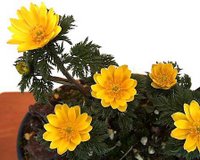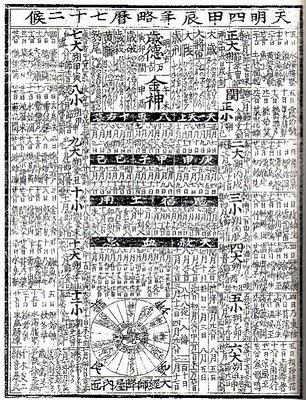[ . BACK to WORLDKIGO TOP . ]
::::::::::::::::::::::::::::::::::::::::::::::::::::::::::::::::::::::::::::::::::::::::::::::::::::
New Year begins (nenshi)
***** Location: Japan
***** Season: New Year, others see below
***** Category: Humanity
*****************************
Explanation
WORK and Business in all seasons
- - - Let us first look at the New Year.
The new year begins with a lot of rituals and ceremonies and starts with three official holidays on January 1 till 3. Later the first work of the year is started, usually with some rituals only.

:::::::::::::::::::::::::::::::::::::::::::::::::::::::::::::::::::::::::::::::::::::::::::::::::::
nenshi 年始 (ねんし) new year begins
nenga 年賀(ねんが)greeting at the New Year
..... nenrei 年礼(ねんれい)、toshi no rei 年の礼(としのれい)、hatsu rei, hatsurei 初礼(はつれい), kairei 回礼(かいれい)
gyokei 御慶(ぎょけい)celebrating the New Year
reisha 礼者(れいじゃ)person who celebrates the New Year
gakyaku 賀客(がきゃく)visitor for the New Year
nenga kyaku 、年賀客(ねんがきゃく)
kadorei 門礼(かどれい)
New Year visitor ("at the gate" )
He gives his greetings at the entrance (kado) and does not come into the house.
..... 門礼者(かどれいじゃ)
reiuke, rei-uke 礼受(れいうけ)
receiver of new year wishes
reija uke 礼者受(れいじゃうけ)
reichoo 礼帳(れいちょう)
book for signing New Year wishes
reiuke choo, rei-uke choo 礼受帳(れいうけちょう)book to sign
..... kado no reichoo 門の礼帳(かどのれいちょう)
meishi uke 名刺受(めいしうけ)container to leave your New Year business card
meishi kookan kai 名刺交換会(めいしこうかんかい)first meeting to exchange business cards
. nengajoo 年賀状(ねんがじょう) New Year Greeting Card
..... 賀状(がじょう)
nenshijoo 年始状(ねんしじょう)
They are most important and send to everyone.
kadobiraki 門開き(かどびらき) "opening the gates again"
..... kadoake 門明け(かどあけ)
onnareija 女礼者 (おんなれいじゃ)
female visitor (who brings New Year wishes)
..... onnagagyaku, onna gagyaku 女賀客(おんながきゃく)
..... onnarei 女礼(おんなれい)
Otoshidama お年玉(おとしだま) Money for the New Year
..... toshidama 年玉 (としだま)
Many visitors, especially children, get a small gift of money in an envelope.
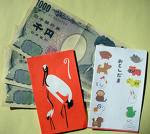
:::::::::::::::::::::::::::::::::::::::::::::::::::::::::::::::::::::::::::::::::::::::::::::::::::::
shinnenkai 新年会 (しんねんかい)
party to welcome the New Year
For workers or sports clubs or other groups where people meet to eat and drink.

:::::::::::::::::::::::::::::::::::::::::::::::::::::::::::::::::::::::::::::::::::::::::::::::::::::
First Business and Office work
Most began on January 11.
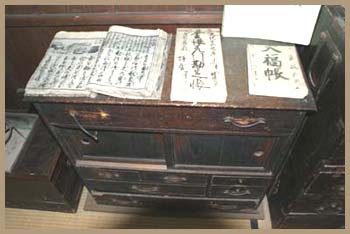
chootoji, choo toji 帳綴 (ちょうとじ)
first bookkeeping, first ledger
ochoodoji 御帳綴(おちょうとじ)
choo iwai 帳祝(ちょういわい)celebrating the account books
choogaki 帳書(ちょうがき)
choo hajime 帳始(ちょうはじめ)
shinkayoi 新通(しんかよい)
This was done by the merchants on January 11. They would make the first entry in the account books (choobo 帳簿) and then celebrate with their workers and pray for a busy new year.
goyoo hajime 御用始 (ごようはじめ)
first business
..... jimu hajime 事務始(じむはじめ)
first office work
..... hatsujimu 初事務(はつじむ)
koto hajime 事始
beginning of work and activities
February 8. Work stopped on December 8.
Both days with an 8 are called "Days of Work (things)" (koto no hi 事の日).
.....koto no yooka 事八日(ことようか)"day number 8"
..... okoto, o-koto おこと
okoto jiru お事汁(おことじる)soup eaten on the first day of work
itokoni 従兄煮(いとこに)itokoni stew
mushitsujiru むしつ汁(むしつじる)
.................................................................................
hatsu akinai, hatsuakinai 初商 (はつあきない)
first business deal
..... akinai hajime 商始(あきないはじめ)
akinaizome 商初(あきないぞめ)
hatsu-uri 初売(はつうり)
first sales
urizome 売初(うりぞめ), hatsu uridashi 初売出し(はつうりだし)
hatsu ichi, hatsuichi 初市 (はついち)
first market
hatsu tachiai 初立会(はつたちあい)
daihakkai 大発会(だいはっかい)
hatsu sooba 初相場(はつそうば)
first stock quotations
ichi hajime 市始(いちはじめ)
hatsu ichiba 初市場(はついちば)
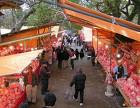
. . . . .
Markets to Sell Daruma Dolls / 達磨市 at the New Year
hatsuni 初荷 (はつに)
first luggage, load, freight
hatsuni uma 初荷馬(はつにうま)first horse with luggage
kazari uma, kazari-uma 飾馬(かざりうま)decorated horse
..... hatsuniguruma 初荷車(はつにぐるま)first car with luggage
hatsunibune 初荷船(はつにぶね)first ship with luggage
hatsuni eki 初荷駅(はつにえき)station handling first luggage
. hatsuni zori 初荷橇(はつにぞり)first sledge with luggage
(especially in Northern Japan)
. Carrying luggage in the Edo period .
.................................................................................
kaizome 買初 (かいぞめ)
first buying
..... hatsukai 初買(はつかい)
kurabiraki 蔵開 (くらびらき)
first opening of the store house
..... okurabiraki 御蔵開(おくらびらき)
Storehouse (kura)
tanaoroshi, tana oroshi 店卸 (たなおろし)
make the inventory
..... 棚卸(たなおろし)
Inventur, Lageraufnahme
正月の遊び仕事や店おろし
shoogatsu no asobi shigoto ya tana oroshi
at the New Year
playing is really working ...
checking the account books
Yuki Sanchi 雪珊
:::::::::::::::::::::::::::::::::::::::::::::::::::::::::::::::::::::::::::::::::::::::::::::::::::::
observance kigo for the New Year
matsurigoto hajime 政始 beginning of political activities
ritual at the imperial court, after the
Misaie, Mi Sai E 御斎会, on an auspicious day.
The duties at Ise shrine were also started on this day.
. WKD : Matsurigoto 政 .
The importance of a matsuri, a festival for the appeasement of the deities, can also be seen in the word
matsurigoto, a word that originated in the performance of religious festivals by the emperor or regent and soon became identical with "governing" in general.
SAIJIKI – NEW YEAR OBSERVANCES
::::::::::::::::::::::::::::::::::::::::::::::::::::::::::::::::::::::::::::::::::::::::::::::::::::
::::::::::::::::::::::::::::::::::::::::::::::::::::::::::::::::::::::::::::::::::::::::::::::::::::
shigoto hajime 仕事始 (しごとはじめ) "first work"
first day at work
.... hatsushigoto, hatsu shigoto 初仕事(はつしごと)
Here are a few things done for the first time in the New Year, around the home, the garden, the farm, the mountain forest and other places where people work during the year.
Most remind us of the harsh life of the farmers of old.
 choona hajime 手斧始 (ちょうなはじめ)
choona hajime 手斧始 (ちょうなはじめ)
first use of the carpenter's ax
choona hajime 釿始(ちょうなはじめ)
kanna hajime 鉋始(かんなはじめ)first use of the plane
kozukuri hajime 木造始(こづくりはじめ) first woodwork
The carpenters' tools were very important, and many of these first rituals were performed in a temple or shrine, to pray for the safety of the wood workers, carpenters and carvers during the coming year.
choona was a very special bend ax for the carpenters to process large beams.
observance kigo for the New Year
. Tennooji Kondoo choona hajime
天王寺金堂手斧始 (てんのうじこんどうちょうなはじめ
first use of the carpenter's ax .
Temple Shitenno-Ji - 四天王寺, Osaka
fuigo hajime 鞴初,吹革初 first use of the bellows
kaji hajime 鍛冶初 first use of the smithy
ihajime 鋳始 いはじめ first casting (of metal)
..... imono hajime 鋳物始(いものはじめ)
izome 鋳初(いぞめ)
.................................................................................
hatsugoe 初肥 (はつごえ)
first manure
..... koeshoi 肥背負(こえしょい)carrying manure on the back
..... koe hikizome 肥曳初(こえひきぞめ)first spreading of manure
koedashi 肥出(こえだし)putting out manure
..... mochizome 持初(もちぞめ)
This is done in a ritual way as an offering for the Deity of the fields (ta no kami), usually on January 11. In Northern Japan, manure is transported to the fields in a sledge.
hatsuhori, hatsu hori 初彫 (はつほり)
first carving
..... horizome 彫初(ほりぞめ)
..... hatsu chookoku 初彫刻(はつちょうこく)
..... 細工始 (さいくはじめ)
first piece of craftsmanship
hatsuzaiku 初細工(はつざいく)
First carving of the woodcarvers, making Buddhist stautes, masks for Noh or decorations for the palaces, temples and shrines. Before starting the work, the master of the workshop will put some offerings to the deities.
hatsuono 初斧(はつおの)
first use of the ax (for woodcutting)
..... hatsuono 初斧(はつおの)
..... kikorizome 樵初 (きこりぞめ)
kikirizome 木伐り初(ききりぞめ)first woodcutting
..... korizome こり初(こりぞめ)
yohoogiri 吉方伐り(よほうぎり)
honaga 穂長(ほなが)"long ears of rice"
This ritual has various names in different parts of Japan. Before cutting the first tree, mochi and sake was offered to the Deity of the Forest and the woodcutters prayed for safe working conditions. Sometimes the mochi offerings were taken back home and preserved until spring for the first field work, as a prayer for good harvest, hence the name "long ears of rice".
. . . hatsuryoo 初漁 (はつりょう) first fishing
hatsuyama 初山 (はつやま)
first mountain work
..... yama hajime 山始(やまはじめ),
yamairi 山入(やまいり)going to the mountain (for the first time)
hatsuyamabumi 初山踏(はつやまぶみ)stepping on the mountain (for the first time)
wakayamabumi 若山踏(わかやまぶみ)stepping on the "young mountain"
hatsu nobori 初登(はつのぼり)first climbing the mountain
yamahome 山誉め(やまほめ)
futsukayama 二日山(ふつかやま)"mountain on the second day"
Ritually entering a mountain forest to make offerings to the deities. Mostly on January 11.
hatsuzome 初染 (はつぞめ)
first dyeing with colors
..... some hajime 染始(そめはじめ)
Farmers wifes used to dye their own threads and fabrics at home.
.................................................................................
kamahajime, kama hajime 窯始 (かまはじめ)
frist firing of the kiln
..... hatsugama 初窯(はつがま)
Potters decorate the kiln with shimenawa decorations, make offerings of salt and sake and pray for the security of the workplace. A ritual of the potters.
.................................................................................

kuwa hajime, kuwahajime 鍬始 (くわはじめ)
first use of the plough or hoe
..... kuwazome 鍬初(くわぞめ)
ookuwazome 大鍬初(おおくわぞめ)first use of the big plough
... tauchi shoogatsu 田打正月(たうちしょうがつ)New Year ploughing
tsukurizome 作初(つくりぞめ)
sukizome 鋤初(すきぞめ)first use of the spade or plow
horizome 堀初(ほりぞめ)first digging
hatsu tauchi 初田打(はつたうち)first ploughing
hatsu kuwa-ire 初鍬入(はつくわいれ)
o-kuwatate お鍬立(おくわたて)
nootate 農立(のうたて)
beginning of farm work
noo hajime 農始(のうはじめ)
kuwa can refer to the hoe held by hand or to the plough.
Hacke; Feldhacke; Haue; Spaten; Pflug.
Farm work was the most important and during the New Years days the movements of various activities were made in the front garden whilst praying for a good harvest, mostly on the 11th day of January. Sometimes grains and salt or even mochi were carried to the fields and offerend to deities.
Some rituals were also performed in the Shinto shrines.
はつ旭鍬も拝まれ給ひけり
hatsu asahi kuwa mo ogamare tamai keri
year's first sunrise--
even the hoe
gets a prayer
Tr. David Lanoue
. Kobayashi Issa 小林一茶 .
observance kigo for mid-winter
kuwa osame 鍬納(くわおさめ)
putting the hoe/plough away
before the New Year celebrations
.................................................................................
naizome 綯初 (ないぞめ)
first making of ropes
..... yorizome 縒初(よりぞめ), sabakizome 捌初(さばきぞめ), tatakizome 叩初(たたきぞめ
nawa iwai 縄祝(なわいわい)"celebrating the ropes"
nodenai 苗手綯(のでない)
Only straw ropes for the farmers' New Year ceremonies are twisted. In some areas on the fourth of January, in others this is done on the third.
nodenai, node nai are thin ropes to bundle the rice.
nuizome 縫初 (ぬいぞめ)
first sewing
..... nuihajime 縫始(ぬいはじめ)
hatsuhari, hatsu hari 初針(はつはり)"first needle"
.... hari okoshi 針起し(はりおこし)
tachizome 裁初(たちぞめ)
This was done on the second of January. Usually a small bag was sewed.
.................................................................................
orizome 織初 (おりぞめ) first weaving
..... hatsu hata, hatsuhata 初機(はつはた)first use of the loom
hata hajime 機始(はたはじめ)
hataba hajime 機場始(はたばはじめ)frist use of the loom room
hataya hajime 、機屋始(はたやはじめ)first use of the loom shed
This was done on the second of January.
Weaving was common in many areas in winter at home or in a special room.
Nishijin, Weaving from Kyoto 西陣織り
Festival of the Weaver Girl, Tanabata Star Festival
Weaving - Haiku from Kenya
Weaving in Romania
Photos from Alex Serban
. orimono 織物 weaving - somemono 染物 dyeing .
.................................................................................
usu okoshi 臼起し (うすおこし)
first use of the mortar
On the second of January, new mochi are pounded, sometimes only the gestures are made, and put as offerings for the deities on the Shinto Shelf (kamidana).
:::::::::::::::::::::::::::::::::::::::::::::::::::::::::::::::::::::::::::::::::::::::::::::::::::::
:::::::::::::::::::::::::::::::::::::::::::::::::::::::::::::::::::::::::::::::::::::::::::::::::::::
Now some work-related kigo for other seasons.
kigo for late spring
shin shain, shin sha-in 新社員 (しんしゃいん )
new employee, new member of the staff
shinnyuu shain 新入社員(しんにゅうしゃいん)
shuushoku ki 就職期(しゅうしょくき)
season for finding work or getting a job
shuudan shuushoku 集団就職(しゅうだんしゅうしょく)
hatsu shussha 初出社(はつしゅっしゃ)
first going to the office
nyuusha shiki 入社式(にゅうしゃしき)
initiation ceremony (at the office)
shuntoo 春闘 (しゅんとう)
annual spring labor offensive
shunki toosoo 春期闘争(しゅんきとうそう)
shunki toosoo 春季闘争(しゅんきとうそう)
Frühjahrsoffensive der japanischen Gewerkschaften
.................................................................................
observance kigo for late spring
harugoto 春ごと ( はるごと) "spring things"
..... haru no koto 春の事(はるのこと)
..... kotobi 事日(ことび)
..... koto matsuri, kotomatsuri 事祭(ことまつり)
regional spring celebration.
In Kanto on February 2, or on March 18 or 21.
In Kansai on a day in March or April.
In other regions on a day when it rained in spring.
People would take a day off from work, enjoy a walk in the fields, take a boat trip, prepare mochi ricecakes or other festival food and have a drink of sake.
:::::::::::::::::::::::::::::::::::::::::::::::::::::::::::::::::::::::::::::::::::::::::::::::::::::
kigo for late summer
natsugare 夏枯 (なつがれ) "withering away in summer"
summer slump, slack summer season 夏枯れ
The second and eigth month of the lunar calendar were the slowest for business, just after the new year and after the ancestor O-Bon festival.
Especially in summer many people went home, or were away in summer holidays and few visitors came to the shops in the big cities.
:::::::::::::::::::::::::::::::::::::::::::::::::::::::::::::::::::::::::::::::::::::::::::::::::::::
kigo for mid-winter
in preparation for the New Year
Haki osame 掃納 (はきおさめ) end of sweeping the floors
Hari osame 針納(はりおさめ) end of the needlework
Koto osame 事納 (ことおさめ)
end of work
..... osame yooka 納め八日(おさめようか) end on the eighth day
Many stores and offices stopped work on this day and attended to ceremonies for the end of the year.
Work began again on January 8.
. mi matsuri 箕祭 (みまつり)
festival when putting the winnow away
..... mi osame 箕納(みおさめ)
*****************************
Worldwide use
*****************************
Things found on the way
*****************************
HAIKU
酔蟹や新年会の残り酒
yoigani ya shinnenkai no nokorizake
"drunken crabs" -
the New Year party
and my hangover
Masaoka Shiki 正岡子規
yoigani, a kind of Shanghai crab preserved in alcohol.
. . . CLICK here for crab Photos !
:::::::::::::::::::::::::::::::::::::::::::::::::::::::::::::::::::::::::::::::::::::::::::::::::::::
三寸の胸ですむ也店おろし
san-zun no mune de sumu nari tanaoroshi
there's so little
I do it in my head...
New Year's inventory
Kobayashi Issa
Here, Issa mentions a "heart" (mune) at a size of 3 sun (1 sun = approximately 1.2 inches, therefore 3 sun = around 3.6 inches). Shinji Ogawa notes that sanzun no mune ("three-inch heart") isn't an anatomical heart, but rather the heart of mental activities; in this case, the English word, "mental" of "mental arithmetic." He paraphrases Issa: "Since there are not so many things, my inventory is done mentally."
Tr. and Comment by David Lanoue
*****************************
Related words
. . . First Things done at the New Year
*****
. NEW YEAR
KIGO for HUMANITY
. SAIJIKI - THE NEW YEAR
:::::::::::::::::::::::::::::::::::::::::::::::::::::::::::::::::::::::::::::::::::::::::::::::::::



